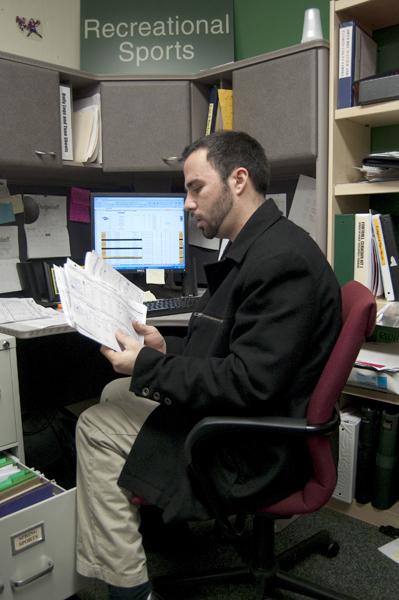Students face challenges of organizing, running teams

Sean Basso:Intramurals coordinator Sean Basso updates standings of the men?s five-on-five basketball games.:Robert Linggi State Hornet
March 3, 2010
Intercollegiate Athletics on campus have a whole department devoted to their smooth running. In contrast Recreational Sports Clubs have to do everything themselves, with the help of the Recreational Sports department.
Recreational Sports Clubs are made up of students who have a desire to compete in sports at the college level.
Students come together and create sports clubs that compete with other clubs from different schools.
Some sport clubs here at Sacramento State include ice hockey, women’s rugby and women’s volleyball.
In order to form a club sport, students must first meet with Rich Clakeley, coordinator of Sports Clubs for Recreational Sports, and meet certain requirements.
“The club needs eight members. Two officers then need to attend nuts and bolts, then a description of who they are needs to be written, and then a constitution needs to be filled out,” Clakeley said.
Club sports are different than varsity intercollegiate sports. A varsity intercollegiate sport has a large staff personally responsible for the scheduling of games between other schools and scheduling practices. Official intercollegiate sports are governed by the NCAA.
Varsity club sports have two departments, the office of Student Organizations and Leadership and the office of Recreational Sports, that help them find and manage available resources.
In order for varsity club sports to begin competing, they must first be recognized as an official club by the office of Student Organizations and Leadership.
Bill Macriss, deputy director of athletics, stated that in most cases, schools carry sports that are regional in nature.
“Many sports are regional and are not always found in the Western states,” Macriss said. “For example, hockey is not a typical sport you would find in our region due to the make of weather and regional interest.”
Other reasons include, funding, coverage by athletic conference and Title IX rules.
Title IX is a regulatory law that requires schools of higher education to provide equal facilities and comparable spending for both women’s and men’s sports. This also includes the ratio of men to women competing in an intercollegiate program be as equal as possible.
Clakeley helps the clubs with organization, management and small business skills. He said the students need to schedule their own games, find places to practice and hire a coach, on top of learning the business aspects.
Ice hockey President Justin Ellison said the most difficult aspect for the team was getting the team organized.
“They had to find members, get reinstated to the league, Pacific Collegiate Hockey Association and be cleared by the Rec Sports department and Student Affairs,” Ellison said.
The club’s current focus is on sustainability.
“We want our numbers to grow, so we can make this a dominant club on campus,” Ellison said.
The management skills he has learned have proven to be invaluable.
“It will definitely help me later on in life and in my potential careers,” Ellison said.
For new club sports, like cycling, the unfamiliarity of campus rules and regulations pose the biggest challenge. Emily Kachorek, cycling club president, said she finds the process a little daunting.
Kachorek said her main challenge is “getting team members to take greater responsibility and leadership roles within the club.”
Management skills for Kachorek have taught her some valuable skills.
“I have learned that I need to become more comfortable delegating responsibility to others,” Kachorek said.
Kachorek takes great pleasure seeing her teammate’s excitement for riding and racing their bikes.
Recreational Sports clubs do a lot to maintain their clubs in order to complete, but for Kachorek and Ellison, it is all worth it.
“Not everyone gets a chance to play an intercollegiate sport in college,” Ellison said. “But being on a sports club, you get that chance to compete at a high level, while making life long friends and learning how to run an organization.”
Matt Harrington can be reached at mharrington@statehornet.com































































































































